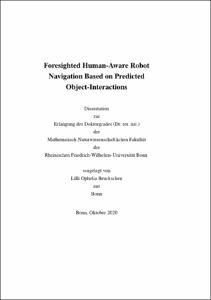Bruckschen, Lilli Ophelia: Foresighted Human-Aware Robot Navigation Based on Predicted Object-Interactions. - Bonn, 2020. - Dissertation, Rheinische Friedrich-Wilhelms-Universität Bonn.
Online-Ausgabe in bonndoc: https://nbn-resolving.org/urn:nbn:de:hbz:5-59983
Online-Ausgabe in bonndoc: https://nbn-resolving.org/urn:nbn:de:hbz:5-59983
@phdthesis{handle:20.500.11811/8745,
urn: https://nbn-resolving.org/urn:nbn:de:hbz:5-59983,
author = {{Lilli Ophelia Bruckschen}},
title = {Foresighted Human-Aware Robot Navigation Based on Predicted Object-Interactions},
school = {Rheinische Friedrich-Wilhelms-Universität Bonn},
year = 2020,
month = nov,
note = {Since the beginning of the digital revolution robots have become an increasingly important part of modern live. Until recently, this trend was primarily observable in industrial robots, however, with the success of the first mass produced household assistance robots like Roomba and Pepper, a shift towards consumer robots is on the horizon. This shift also leads to the need for new research regarding the behavior of robots in domestic spaces, as principles suitable for industrial robots may not be compatible with domestic robots. This thesis is concerned with research in this field and presents a novel navigation approach for foresighted human-aware robot navigation using predicted human-object interactions. The approach is based on the core idea that the last object interaction of a human carries knowledge about the next object interaction. Given enough training data this knowledge in combination with active observations can be a powerful tool to estimate likely navigation goals of a moving human user. Such predictions can then be used to guess the path the user will take to their next navigation goal and in turn adapt the path of the robot such that it will not disturb the user. Furthermore, in case of a service robot the prediction could also be used to guess at which destinations the user might need the assistance of the robot, thereby increasing the efficiency of it. The experimental evaluations in simulated and real world environments highlight that the presented approach can outperform state-of-the-art approaches both in the path efficiency of the robot as well as in the comfort of the human. The results thereby also show the usefulness of long-term planing and human-aware movement and that path efficiency and human comfort can go hand in hand.},
url = {https://hdl.handle.net/20.500.11811/8745}
}
urn: https://nbn-resolving.org/urn:nbn:de:hbz:5-59983,
author = {{Lilli Ophelia Bruckschen}},
title = {Foresighted Human-Aware Robot Navigation Based on Predicted Object-Interactions},
school = {Rheinische Friedrich-Wilhelms-Universität Bonn},
year = 2020,
month = nov,
note = {Since the beginning of the digital revolution robots have become an increasingly important part of modern live. Until recently, this trend was primarily observable in industrial robots, however, with the success of the first mass produced household assistance robots like Roomba and Pepper, a shift towards consumer robots is on the horizon. This shift also leads to the need for new research regarding the behavior of robots in domestic spaces, as principles suitable for industrial robots may not be compatible with domestic robots. This thesis is concerned with research in this field and presents a novel navigation approach for foresighted human-aware robot navigation using predicted human-object interactions. The approach is based on the core idea that the last object interaction of a human carries knowledge about the next object interaction. Given enough training data this knowledge in combination with active observations can be a powerful tool to estimate likely navigation goals of a moving human user. Such predictions can then be used to guess the path the user will take to their next navigation goal and in turn adapt the path of the robot such that it will not disturb the user. Furthermore, in case of a service robot the prediction could also be used to guess at which destinations the user might need the assistance of the robot, thereby increasing the efficiency of it. The experimental evaluations in simulated and real world environments highlight that the presented approach can outperform state-of-the-art approaches both in the path efficiency of the robot as well as in the comfort of the human. The results thereby also show the usefulness of long-term planing and human-aware movement and that path efficiency and human comfort can go hand in hand.},
url = {https://hdl.handle.net/20.500.11811/8745}
}






